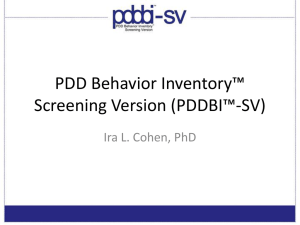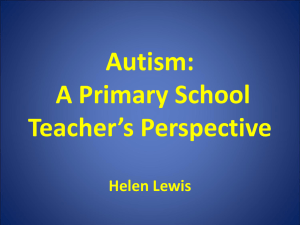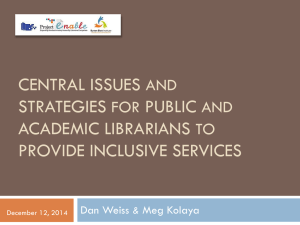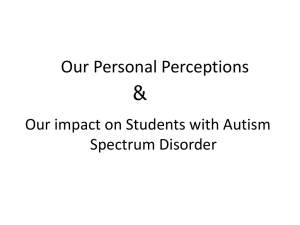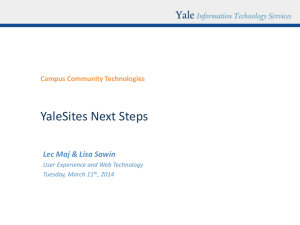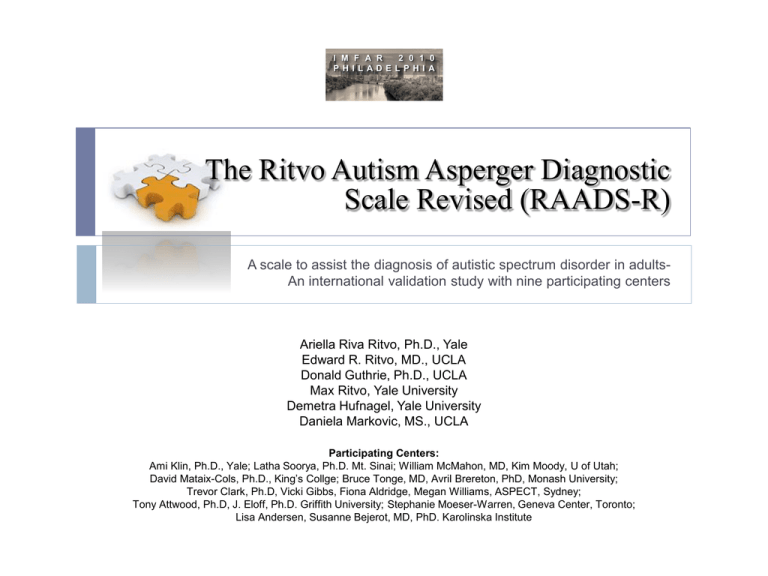
I M F A R
2 0 1 0
P HI L ADE L P HI A
The Ritvo Autism Asperger Diagnostic
Scale Revised (RAADS-R)
A scale to assist the diagnosis of autistic spectrum disorder in adultsAn international validation study with nine participating centers
Ariella Riva Ritvo, Ph.D., Yale
Edward R. Ritvo, MD., UCLA
Donald Guthrie, Ph.D., UCLA
Max Ritvo, Yale University
Demetra Hufnagel, Yale University
Daniela Markovic, MS., UCLA
Participating Centers:
Ami Klin, Ph.D., Yale; Latha Soorya, Ph.D. Mt. Sinai; William McMahon, MD, Kim Moody, U of Utah;
David Mataix-Cols, Ph.D., King’s Collge; Bruce Tonge, MD, Avril Brereton, PhD, Monash University;
Trevor Clark, Ph.D, Vicki Gibbs, Fiona Aldridge, Megan Williams, ASPECT, Sydney;
Tony Attwood, Ph.D, J. Eloff, Ph.D. Griffith University; Stephanie Moeser-Warren, Geneva Center, Toronto;
Lisa Andersen, Susanne Bejerot, MD, PhD. Karolinska Institute
Background
The RAADS-R is a modified version of the Ritvo Autism Asperger
Diagnostic Scale. The rationale for its development, its method of
construction, and its comparison to other similar scales have been
published in JADD in 2008 .
The first version of the RAADS contained 78 questions. Published
data demonstrated it had high validity, reliability, sensitivity, and
specificity in a limited number of subjects.
Questions on the initial RAADS assess developmental pathology in
three symptom areas: language, social relatedness, and sensorymotor (re. DSM-IV-TR). After critical review and the results of a factor
analysis, a revised 80-item version was developed (the RAADS-R)
with the addition of a fourth symptom area (circumscribed interests),
two questions, and several word clarifications.
© Ariella Riva Ritvo, Ph.D. Yale; Edward R. Ritvo, MD 2010
Slide 2
Objectives
To describe the methods and present the results of the nine
university international standardization study of the new 80item RAADS-R.
© Ariella Riva Ritvo, Ph.D. Yale; Edward R. Ritvo, MD 2010
Slide 3
Methods
1.
A uniform protocol was used by all centers
2.
IRB consent was obtained by each center
3.
All subjects signed informed consent
Participating Subject Groups:
Autism Spectrum Disorder Subjects N = 201
1.
2.
66 subjects with a diagnosis of Autistic Disorder
135 subjects with a diagnosis of Asperger’s Disorder
Comparison Subjects N = 578
1.
2.
276 subjects with no DSM-IV-TR diagnosis
302 subjects with other DSM-IV-TR diagnoses
© Ariella Riva Ritvo, Ph.D. Yale; Edward R. Ritvo, MD 2010
Slide 4
Methods
ASD Subjects (groups 1 and 2 n = 201)
Uniformly diagnosed by research criteria :
1. A clinical interview (DSM-IV-TR diagnostic criteria met)
2. ADI/ADOS Scale (ADOS module IV at least) to establish
concurrent validity
3. Standardized IQ test, (WAIS or WASI) full IQ of =/> 80
4. Constantino Social Responsiveness Scale-Adult (SRS-A)
to assess concurrent validity when available (69 subjects)
5. Repeat testing to assess reliability
Comparison subjects (groups 3 and 4 n = 578 ):
1. Volunteers without a DSM-IV-TR diagnosis
2. Volunteers with current DSM-IV-TR diagnosis other than
ASD
© Ariella Riva Ritvo, Ph.D. Yale; Edward R. Ritvo, MD 2010
Slide 5
Methods
Administration of RAADS-R:
1.
ASD subjects: Following initial screening, a clinician interviewed each
subject to confirm the diagnostic information and IQ data, completed the
ADI/ADOS or ADOS module IV, and then introduced the scale and
explained how to answer the questions. The clinician remained with each
subject as the questions were being answered to offer clarifications when
asked, and to make sure answers were entered in the proper columns on
the Likert scale. An SRS–A scale was obtained from cooperating
accompanying adults when available.
2.
Comparison Subjects: All were given the RAADS-R to complete in the
presence of a clinician. All comparison subjects were clinically evaluated to
determine that their IQ was 80 or above.
3.
Each of the 9 participating centers was asked to score, review and mail in
full packets of ASD subjects. Some of the participating centers contributed
data to the comparison group subject pool.
© Ariella Riva Ritvo, Ph.D. Yale; Edward R. Ritvo, MD 2010
Slide 6
Translations
Translations took into account cultural/idiomatic variations.
Questions addressed core symptoms regardless of language,
which will allow for standardization of results and assessment
of validity and reliability. Some studies are well on their way
(Swedish and Japanese) while others (French and Hindi) are
in early stages. Standard protocol and translation methods are
being followed.
Studies are being conducted in:
1. Swedish: Lisa Andersen, Ph.D, Susanne Bejerot, MD,
PhD, Karolinska Institute
2. Japanese: Prof. Masatsugu Tsujii, Kaori Matsumoto, Kenji
Tsuchiya, Nagoya, Japan
3. Hindhi
4. French
© Ariella Riva Ritvo, Ph.D. Yale; Edward R. Ritvo, MD 2010
Slide 7
Results: Demographics
Males
Females
Highest grade
N
N
%
N
%
Mean
age
Autistics
66
52
79.1
14
20.9
30.81
Asperger
135
93
68.9
42
31.1
ASD
201
145
72.1
56
No DSM-IV-TR
276
114
41.3
Other DSM-IV-TR
302
134
All controls
578
Total study
population
779
Married
%
Mean
IQ
High
School
College
Graduate
13.4
52.2
37.3
10.4
114
32.01
21.5
37.8
53.3
7.4
122
27.9
31.45
18.9
45.0
45.3
8.9
119
162
58.7
41.51
39.5
37.7
46.0
16.3
N/A
44.4
168
55.6
42.04
28.5
40.1
53.3
6
N/A
248
42.9
330
57.1
41.78
33.7
38.9
49.7
11.2
N/A
394
44.4
386
49.5
29.9
39.9
49.4
10.3
N/A
© Ariella Riva Ritvo, Ph.D. Yale; Edward R. Ritvo, MD 2010
Slide 8
Results
Diagnostic Accuracy (Sensitivity and Specificity):
Utilizing a cut off RAADS-R score of 65, six ASD subjects from three of the
nine centers scored below, and thus were in the non ASD range. They are
labeled “false negatives,” yielding sensitivity for the RAADS-R of 97%. None
of the comparison subjects scored above 65, so there were no false positives.
Thus the specificity for the RAADS-R is 100%.
Pair-wise comparison of each of the 80 questions
Post-hoc unequal variance t-tests were performed for pair-wise comparison of
each of the 80 questions. The ASD subjects differed significantly from the
comparison groups on all 80 questions (p < 0.0001 for all questions).
The mean RAADS-R scores of the ASD, the Autistic, and the Asperger groups
from all nine centers are significantly different (p < 0.0001) from the combined
mean of the comparison groups, and the mean for each of the nine research
centers.
Cronbach Alpha coefficients demonstrate good internal consistency.
© Ariella Riva Ritvo, Ph.D. Yale; Edward R. Ritvo, MD 2010
Slide 9
Cronbach Alpha Coefficients
Circumscribed Interests
9, 13, 24, 30, 32, 40, 41, 50, 52, 56, 63, 70, 75, 78
Alpha = .903
Language
2, 7, 27, 35, 58, 66, 15
Alpha = .789
Sensory Motor
10, 19, 4, 33, 34, 36, 46, 71, 16, 29, 42, 49, 51,
57, 59, 62, 65, 67, 73, 74
Alpha = .905
Social
1, 6, 8, 11, 14, 17, 18, 25, 37, 38, 3, 5, 12, 28, 39,
44, 45, 76, 79, 80, 20, 21, 22, 23, 26, 31, 43, 47, 48,
53, 54, 55, 60, 61, 64, 68, 69, 72, 77
Alpha = .923
© Ariella Riva Ritvo, Ph.D. Yale; Edward R. Ritvo, MD 2010
Slide 10
Factor Analysis
Factor Analysis was carried out using both Varimax (orthogonal) and Oblique (non
orthogonal) rotation. Results were compared between the two rotational strategies. The
Oblique rotational method was chosen because we assume the underlying constructs are
interrelated.
We identified four factors. To compare the model derived factors versus the assigned four
subdomains (DSM-IV-TR), we computed the Pearson correlation. Factors I and IV
correlated most strongly with the social construct (r =.80). Factor II correlated most strongly
with circumscribed interests (r =.78), factor III with sensory motor (r =.88).
The language construct was not picked up with the four factor model. However, the factor
analysis is a mathematical computation of clusters and picks up on key words, missing the
nuances in these questions. For instance, the question: “the phrase ‘I’ve got you under my
skin’ makes me feel uncomfortable” is clearly a language construct question and targets
concrete language and lack of understanding symbolic language. The factor analysis
loaded it as a sensory motor question, most likely because it contained the words “skin” and
“uncomfortable”.
We will report the variances accounted for by each factor and the Cronbach alpha
coefficients, but upon review of the loadings, we remain confident that the original
assignments of questions reflect the clinical picture with more clinical relevance. Either way,
the instrument has good internal consistency.
© Ariella Riva Ritvo, Ph.D. Yale; Edward R. Ritvo, MD 2010
Slide 11
Factor Analysis
Factor I accounts for 23.9% of the variance with a Cronbach
alpha coefficient of .93
Factor II accounts for 25.0 % of the variance with a Cronbach
alpha coefficient of .95
Factor III accounts for 22.4 % of the variance with a Cronbach
alpha coefficient of .87
Factor IV accounts for 18.9% of the variance with a Cronbach
alpha coefficient of .89
© Ariella Riva Ritvo, Ph.D. Yale; Edward R. Ritvo, MD 2010
Slide 12
Factor Analysis
Factor I: Social, containing questions related to empathy, intimacy and social language
Questions: 1, 6, 8, 11, 13, 14, 15, 16, 18, 31, 37, 38, 43, 48, 52, 53, 58, 62,
66, 68, 72, 74, 77.
Factor II: Circumscribed Interests, also with questions relating to social blindness
Questions: 3, 4, 5, 7, 9, 12, 16, 17, 20, 22, 25, 27, 28, 32, 33, 39, 41, 44, 45, 49,
50, 56, 60, 64, 76, 78, 79, 80.
Alpha= .87
Factor IV: Social Anxiety
Questions: 21, 23, 26, 30, 42, 47, 55, 61, 63, 67, 69, 75.
Alpha = .95
Factor III: Sensory motor
Questions: 2, 10, 19, 24, 29, 34, 35, 36, 40, 46, 51, 54, 57, 59, 65, 70, 71, 73.
Alpha= .93
Alpha =.89
This factor is important. Targeting the social anxiety questions within the instrument may
help the clinician differentiate social anxiety from ASD. The two are often confused
diagnostically.
© Ariella Riva Ritvo, Ph.D. Yale; Edward R. Ritvo, MD 2010
Slide 13
Test – Retest Reliability
mean interval between tests = 15 months
Subjects
N
Mean RAADS-R
1st Test
Mean RAADS-R
2nd Test
ASD subjects
15
155
149
Comparison subjects
15
20
21
© Ariella Riva Ritvo, Ph.D. Yale; Edward R. Ritvo, MD 2010
Slide 14
Test – Retest Data Statistical Analysis
Subject group
Number
Pearson r=
Spearman Rho=
All subjects
30
.987
.956
Autistic
7
1.0
1.0
Asperger
8
.939
.952
Comparisons
15
.874
.764
© Ariella Riva Ritvo, Ph.D. Yale; Edward R. Ritvo, MD 2010
Slide 15
Validity Data
Type and number of subjects
Percent agreement
Research center’s clinical
criteria (inclusion requirement)
ASD 201
100%
ADI/ADOS or ADOS module 4
(inclusion requirement)
ASD 201
100%
ASD 201
COMPARISON 578
97%
100%
ASD 69
95.69%
RAADS
Sensitivity (6 false negatives)
Specificity (0 false positives)
Constantino SRS-A
Sensitivity (3 false negatives)
© Ariella Riva Ritvo, Ph.D. Yale; Edward R. Ritvo, MD 2010
Slide 16
Validity Data-Constantino Social Responsiveness Scale, Adult (SRS-A)
69 SRS-A were administered to a 3rd party (e.g. parent,
spouse).
SRS-A cutoff t score is 59. Three subjects (4.31 percent)
scored below the cutoff (55, 57 and 58). This is a 95.59%
concordance rate with RAADS-R subjects.
© Ariella Riva Ritvo, Ph.D. Yale; Edward R. Ritvo, MD 2010
Slide 17
Mean RAADS-R Scores and Ranges by Research Center: ASD Subjects
Research center
RAADS-R Scores
N
Mean
Min
Max
UCLA
53
146
84
222
Yale
31
115
48
178
Mount Sinai
19
123
73
166
7
92
72
109
Monsah University, Australia
13
138
62
172
Aspect, Sydney
14
118
58
193
Griffith University, Australia
42
146
56
227
Geneva Center, Canada
8
148
107
216
University of London
14
135
67
205
University of Utah
© Ariella Riva Ritvo, Ph.D. Yale; Edward R. Ritvo, MD 2010
Slide 18
Mean RAADS-R Scores and Ranges – Autism, Asperger and, ASD
RAADS-R Scores
N
Mean
Min
Max
All ASD subjects
201
133.8
44
227
All Autistic subjects
66
138.5
44
227
All Asperger subjects
135
131.5
52
225
© Ariella Riva Ritvo, Ph.D. Yale; Edward R. Ritvo, MD 2010
Slide 19
Mean RAADS-R Scores and Ranges – Comparison Subjects
RAADS
N
Mean
Min
Max
No DSM-IV-TR diagnosis
275
22
0
64
Other DSM-IV-TR diagnoses
302
30
0
65
Total All Comparison subjects
578
25
0
65
© Ariella Riva Ritvo, Ph.D. Yale; Edward R. Ritvo, MD 2010
Slide 20
Characteristics of the only 6 ASD subjects (3%) whose mean RAADS-R scores
were below 65 (false negatives) Sorted by RAADS-R scores (mean age = 19.9)
Center
Diagnosis
N
Sex
School
Yale
Asperger
19
M
HS
Griffith
Asperger
23
M
HS
Aspec
Autistic
18
M
Griffith
Asperger
19
Yale
Asperger
Yale
Asperger
IQ
RAADS-R
120
52
117
56
HS
116
58
M
HS
122
58
20
M
COL
116
59
19
M
COL
116
60
© Ariella Riva Ritvo, Ph.D. Yale; Edward R. Ritvo, MD 2010
SRS
90
Slide 21
Conclusions
No difficulties were reported in administration even though subjects were evaluated at
nine medical centers on three continents.
The RAADS-R proved to be highly accurate in discriminating between subjects with
ASD and those without a DSM-IV-TR diagnosis and with another DSM-IV-TR
diagnosis (Sensitivity = 97%. Specificity = 100).
Mean RAADS-R scores were significantly different (p < 0.0001) between ASD and
comparison subjects at each of the nine centers and in all centers combined.
All eighty questions significantly differentiated between ASD and comparison subjects.
The fact that this was true even when the comparison cases had a variety of DSM-IVTM diagnoses other than ASD makes the RAADS-R particularly useful in adult clinic
clinical settings.
The RAADS-R also demonstrated high test – retest reliability (Pearson Correlation
Coefficient = .987, Spearman Correlation Coefficients = .956).
Concurrent validity with ADI/ADOS was 100% and with Constantino SRS-A
concordance rate was 95.59%.
© Ariella Riva Ritvo, Ph.D. Yale; Edward R. Ritvo, MD 2010
Slide 22
Conclusions
Cronbach alphas were good for the four DSM-IV-TR domains, suggesting a good
internal consistency of the RAADS-R.
Factor analysis with oblique rotation to account for assumed correlation between
constructs yielded four factors, also with good internal consistency.
Because ASD is a behaviorally defined syndrome with subtle nuances and factor
analysis is mathematically based, picking up key words, we prefer to remain with the
original question assignment, which reflects the clinical picture more accurately. That
being said, the Cronbach alpha coefficients are good either way, and the original
subdomains as well as the factors differentiate ASD from non-ASD subjects in a
statistically significant way. The instrument was designed to be used as a whole, and
all questions ultimately have one measurement—ASD symptomatology.
© Ariella Riva Ritvo, Ph.D. Yale; Edward R. Ritvo, MD 2010
Slide 23
Summary
The results from nine medical centers, based on 201
ASD subjects and 578 comparison subjects,
demonstrated that the RAADS-R is highly valid, highly
reliable, and it is easy to administer and to score. Thus
we conclude that it can serve as a valuable asset to
assist clinicians diagnosing ASD in adults eighteen years
and older.
© Ariella Riva Ritvo, Ph.D. Yale; Edward R. Ritvo, MD 2010
Slide 24
Clinical Implications of RAADS Scores
Sensitivity = 97% (6 false negatives)
Specificity = 100% (no false positives)
66
OR ABOVE
HIGHLY LIKELY
TO HAVE ASD
65
OR BELOW
HIGHLY UNLIKELY
TO HAVE ASD
© Ariella Riva Ritvo, Ph.D. Yale; Edward R. Ritvo, MD 2010
Slide 25
The Ritvo Autism Asperger Diagnostic Scale-R
RAADS SCORES
SENSITIVITY = 97%
SPECIFICITY = 100%
MEAN
134
65
ASD N = 201
MEAN
22
MEAN
30
NO OTHER DX N = 276
OTHER DX N = 302
© Ariella Riva Ritvo, Ph.D. Yale; Edward R. Ritvo, MD 2010
Slide 26
Thank you.
© The Ritvo Autism Asperger Diagnostic Scale Revised (RAADS-R) 2010

